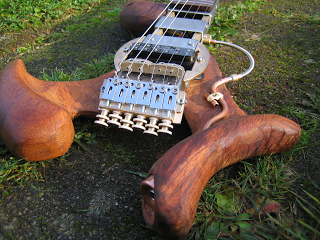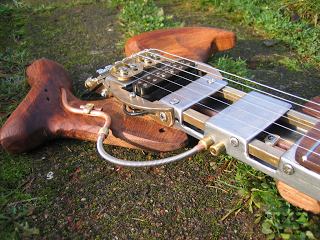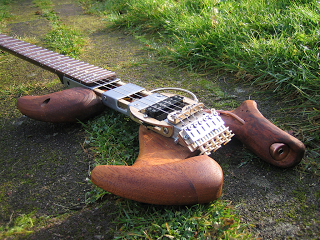Guitar
 This last month I've been improving some details of the testbed guitar:
This last month I've been improving some details of the testbed guitar:
The tuner has been changed to my slider-based design. It is mounted on an angled plate ensuring that the strings have sufficient break angle over the saddles. The angle also keeps the sliders in contact with the plate. I've used six modern strat style saddles for sliders - when I get around to it, I'll make some better (and prettier) ones from brass. Using the right screw hole for securing the string ensures that the pull of the string tightens the screw. It's got more travel than I need, so I'll shorten it around 5 mm. The knurled knobs are standard DIN 466 brass knobs. I've used two for each slider so the fingers have more grip surface. They're interlocking with one another, giving great utilization of the existing space, but making it difficult to remove one without loosening them all.
 The tuner works very well. The grooves and lid that you see on most other headless slider based tuners aren't necessary, as the string pull keeps the slider oriented lengthwise. When I get some tools for making fine thread (M3 and M4 x 0,35), it'll be even smoother.
The tuner works very well. The grooves and lid that you see on most other headless slider based tuners aren't necessary, as the string pull keeps the slider oriented lengthwise. When I get some tools for making fine thread (M3 and M4 x 0,35), it'll be even smoother.
The bridge is an improvement from my earlier design consisting of two saddles each holding three strings, but is a bit simpler: It is reversed, being fixed to the body in front of the contact point of the strings. This gives me a shorter overall design, allowing for the tuner to be placed closer to the bridge.

Action is set by lifting or lowering the saddle with the small blind screws in the bottom and then securing with the big inner hex screws. Intonation is set by turning the blind screws going through the vertical flange of the saddle (they press against the big hex screws).
The jack holder is a copper pipe cap - thanks Martin for the brilliant idea. I'll use them for swithces and potmeters as well. The copper tube holds the wires, shielding them from electrical interference. The flexible cable is a piece of gear cable outer tubing back from the days when I was racing bicycles. It allows for the thigh rest to be moved and turned.
 It is common among some luthiers to give their guitars a name. Since it's a testbed, and bed is called Lectus in latin, I'll call it Lectus Testus. Yes, it's rubbish latin, I know. And yes, it might actually mean something different.
It is common among some luthiers to give their guitars a name. Since it's a testbed, and bed is called Lectus in latin, I'll call it Lectus Testus. Yes, it's rubbish latin, I know. And yes, it might actually mean something different.
Added: I just weighed it: 2,5 kg as it is now. That's not too bad.
- Coarse Tuners Part 5
The coarse tuners that I made for the black SG with the Schaller fine tuning bridge were - after all - too troublesome to string and adjust. I've made another attempt, this time consisting of - a hex screw going through the head plate, - an acorn...
- A Guitar That Works
What started as a testbed has turned into a nice, playable guitar. For the first time, I've made a working guitar that I believe suits my position and style better than anything I could buy. This was the problem, that initially, some four years ago,...
- New Tuner Design
In the previous post, I described my intention of creating a playable testbed for experiments with different pickups. It turned out to be nice to play, so I improved it with a strap horn and the acrylic body from my t-beam bass. As it turned out, it was...
- A Locking Nut That Didn't Work
Since I put the T-beam guitar on hold for a while, I bough a cheap Gibson SG copy for various experiments. One of the first things I wanted to try out was a tuning system, which uses a locking nut in combination with a Schaller 456 fine tuning bridge...
- Bridge And Tuners For The Headless Design
Having settled on a headless design, one of the next questions was which bridge and tuners to use. A small number of bridges with built-in tuners already exist, e.g. the ABM or the Steinberger. Unfortunately, they are all fairly expensive, and it was...
Guitar
New tuner, bridge, jack and tubing

The tuner has been changed to my slider-based design. It is mounted on an angled plate ensuring that the strings have sufficient break angle over the saddles. The angle also keeps the sliders in contact with the plate. I've used six modern strat style saddles for sliders - when I get around to it, I'll make some better (and prettier) ones from brass. Using the right screw hole for securing the string ensures that the pull of the string tightens the screw. It's got more travel than I need, so I'll shorten it around 5 mm. The knurled knobs are standard DIN 466 brass knobs. I've used two for each slider so the fingers have more grip surface. They're interlocking with one another, giving great utilization of the existing space, but making it difficult to remove one without loosening them all.
 The tuner works very well. The grooves and lid that you see on most other headless slider based tuners aren't necessary, as the string pull keeps the slider oriented lengthwise. When I get some tools for making fine thread (M3 and M4 x 0,35), it'll be even smoother.
The tuner works very well. The grooves and lid that you see on most other headless slider based tuners aren't necessary, as the string pull keeps the slider oriented lengthwise. When I get some tools for making fine thread (M3 and M4 x 0,35), it'll be even smoother.The bridge is an improvement from my earlier design consisting of two saddles each holding three strings, but is a bit simpler: It is reversed, being fixed to the body in front of the contact point of the strings. This gives me a shorter overall design, allowing for the tuner to be placed closer to the bridge.

Action is set by lifting or lowering the saddle with the small blind screws in the bottom and then securing with the big inner hex screws. Intonation is set by turning the blind screws going through the vertical flange of the saddle (they press against the big hex screws).
The jack holder is a copper pipe cap - thanks Martin for the brilliant idea. I'll use them for swithces and potmeters as well. The copper tube holds the wires, shielding them from electrical interference. The flexible cable is a piece of gear cable outer tubing back from the days when I was racing bicycles. It allows for the thigh rest to be moved and turned.
 It is common among some luthiers to give their guitars a name. Since it's a testbed, and bed is called Lectus in latin, I'll call it Lectus Testus. Yes, it's rubbish latin, I know. And yes, it might actually mean something different.
It is common among some luthiers to give their guitars a name. Since it's a testbed, and bed is called Lectus in latin, I'll call it Lectus Testus. Yes, it's rubbish latin, I know. And yes, it might actually mean something different.Added: I just weighed it: 2,5 kg as it is now. That's not too bad.
- Coarse Tuners Part 5
The coarse tuners that I made for the black SG with the Schaller fine tuning bridge were - after all - too troublesome to string and adjust. I've made another attempt, this time consisting of - a hex screw going through the head plate, - an acorn...
- A Guitar That Works
What started as a testbed has turned into a nice, playable guitar. For the first time, I've made a working guitar that I believe suits my position and style better than anything I could buy. This was the problem, that initially, some four years ago,...
- New Tuner Design
In the previous post, I described my intention of creating a playable testbed for experiments with different pickups. It turned out to be nice to play, so I improved it with a strap horn and the acrylic body from my t-beam bass. As it turned out, it was...
- A Locking Nut That Didn't Work
Since I put the T-beam guitar on hold for a while, I bough a cheap Gibson SG copy for various experiments. One of the first things I wanted to try out was a tuning system, which uses a locking nut in combination with a Schaller 456 fine tuning bridge...
- Bridge And Tuners For The Headless Design
Having settled on a headless design, one of the next questions was which bridge and tuners to use. A small number of bridges with built-in tuners already exist, e.g. the ABM or the Steinberger. Unfortunately, they are all fairly expensive, and it was...
